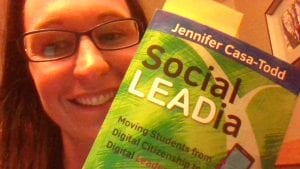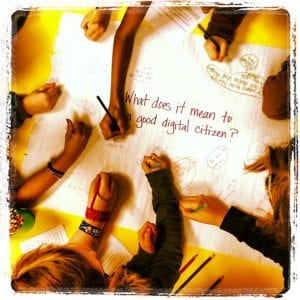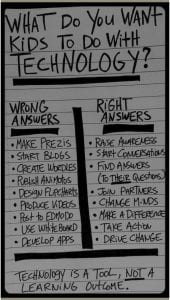Major Project – It is done! 4 of 4
My Major Project is posted…the end is near!
For my final blog post, I decided to give you a glimpse into what creating my final project was like! As soon as I received the syllabus, for this course, I began to get my hamster wheel running. Fortunately, I work with two other classmates from this course, so we began to

Photo Credit:
Jen Resch
brainstorm and come up with a project idea. Though we worked together, our projects were somewhat independent. As you know from my previous posts, I decided to focus on students and how we can build them into Digital Leaders. This idea sparked for me when I heard Jennifer Casa-Todd speak to our Connected Educator group during a skype session. For those of you that have not heard of her, she is a Canadian teacher, author, and presenter who spreads the message of empowering students through social media. She believes in teaching students how to use social media appropriately and for learning, rather than the many inappropriate uses. I have used her book, Social LEADia to help guide me and encourage me toward the goal of teaching my own students how to be Digital Leaders not only within our school, but also online! I dove right in! I highly recommend this book as it will change the way you look at not only social media in the classroom, but also how you use technology in the classroom. I am psyched as I will be able to meet Jennifer Casa-Todd at an upcoming Connected Educator meeting in May! I cannot wait to pick her brain and come out with some new ideas and motivations to encourage me to keep moving forward!
Once I narrowed down my focus, I met again with my team to decide if my focus aligned with their focus. We met several times throughout

Photo Credit:
Rhiannon Hillman
this semester to just check-in, swap ideas, brainstorm, or ask for help. I really am grateful for having them in such close proximity as it helped to keep me motivated and focussed on my goals. We actually recorded one of our meetings, to give you an insight into what our discussions sounded like…this was only a little rehearsed!
One driving factor in this assignment was the idea of changing, or re-working, our existing “Acceptable Use Policy” to include characteristics of a “Responsible Use Policy”. Everything I have read suggests this is the way to go as it empowers students by outlining what they should be doing online and with technology rather than telling them everything they should not be doing online and listing all the consequences that will ensue if they make a mistake. School should be a place to learn, grow, and make mistakes. That should include with technology. Again, Jennifer Casa-Todd created a great, and short, Youtube video outlining the differences between these two policies. I included it in this post for your viewing pleasure.
I have to say, I was pretty impressed with my end-product. Today I submitted a rationale for my project, a 5-day unit plan I created on PowerPoint jam–packed with digital integration and engagement, and a sample Responsible Use Agreement. I liked the word “agreement” better than “policy” because it should be something our students and teachers/administrators are agreeing to. I plan to work this project into my teaching practice and am pretty excited to see how it all plays out!
Thank you so much for joining me on this journey. As always, I look forward to your comments, questions, or insights!
Before I leave you for this term, I thought I would leave you with one last video. I thought it was pretty great, though it did not make my presentation, sadly. Enjoy!














 pedagogy and the integration of technology within my classroom in many of my blog posts this term. The Connected Educator program has completely revolutionized my educational teaching experience. Learning about why we use technology and how to implement it in a meaningful way has enhanced my own beliefs surrounding education.
pedagogy and the integration of technology within my classroom in many of my blog posts this term. The Connected Educator program has completely revolutionized my educational teaching experience. Learning about why we use technology and how to implement it in a meaningful way has enhanced my own beliefs surrounding education.

 “
“








